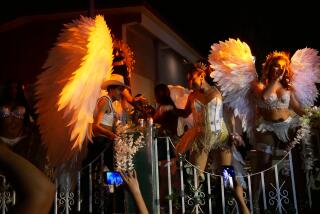Vancouver Virus Genetically Like SARS
Nearly 150 residents and staff members at a Vancouver-area nursing home have come down with a cold-like illness that may be linked to the SARS virus or another that is genetically similar.
Since early July, 94 residents and 50 staffers at Kinsmen Place Lodge in Surrey, a suburb of Vancouver, have shown symptoms of the respiratory illness, according to the British Columbia Center for Disease Control. Of those, six residents died of pneumonia, with the most recent death on Tuesday.
According to the health agency, three of the patients who died and a number of others who were sickened tested positive for the SARS virus, although others did not.
Analysis of a small fragment of the virus -- about 2% of its genetic material -- indicates that it is closely related to severe acute respiratory syndrome, which killed 44 people in Toronto and more than 800 people worldwide when it struck this spring.
But infectious-disease specialists said it was not yet clear how the nursing home virus was related to SARS.
For one thing, the symptoms are quite different from those experienced with SARS. The SARS virus caused a high fever and a severe, atypical form of pneumonia, killing about 15% of the people it sickened.
In contrast, the nursing home virus has been causing far milder, cold-like symptoms typified by runny noses and mild coughs. The illness later developed into pneumonia in 10 residents.
The pneumonia was of the typical type and not the distinctive form associated with SARS, said Sally Greenwood, spokeswoman for the British Columbia Center for Disease Control.
Experts said there were a number of possible ways in which this virus, if it is the cause of the illness, could be related to SARS.
The virus could be a newly discovered member of the coronavirus family, which includes SARS. It could be highly similar to SARS yet cause a different disease. Other coronaviruses are known to cause the common cold.
The virus also might be a watered-down version of SARS, weakened by an accumulation of genetic mutations. Viruses can sometimes lose their lethality as they reproduce repeatedly inside human bodies.
It is also possible that this virus came from the same source as SARS and that the two viruses represent different strains with different severities, just as influenza strains can be strong or weak from one season to the next.
Obtaining a complete genetic sequence of the virus will be crucial in figuring out its origins, said Michael Osterholm, director of the Center for Infectious Disease Research and Policy at the University of Minnesota.
“It’s a ‘stay tuned’ situation,” Osterholm said. “We shouldn’t be coming to too many conclusions yet because there are not enough pieces of information available.”
The nursing home situation underscores the difficulty public health workers will face in the fall and winter distinguishing a reemergence of SARS from outbreaks of colds and influenza.
“People are working hard to come up with diagnostic tests that would be quick and definitive,” said Dr. Stephen Corber, manager for disease prevention and control at the Pan American Health Organization in Washington. Don Bower, spokesman for the Fraser Health Authority, which oversees the Kinsmen nursing home, said the infection appeared to have peaked. As of Wednesday, 19 patients were in isolation and two staffers remained off work, he said.
Toronto was the Canadian city hit hardest by SARS. However, British Columbia did have four probable and 46 suspected cases of the disease, with no deaths.
More to Read
Start your day right
Sign up for Essential California for news, features and recommendations from the L.A. Times and beyond in your inbox six days a week.
You may occasionally receive promotional content from the Los Angeles Times.






